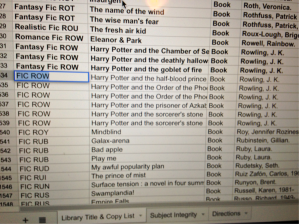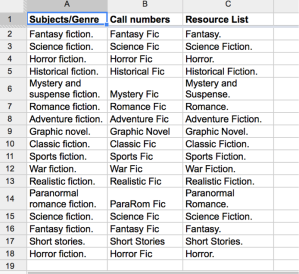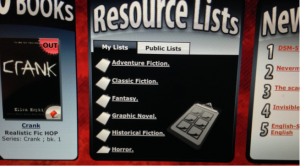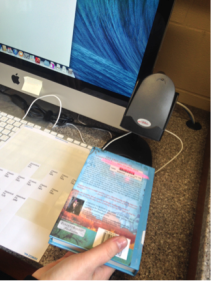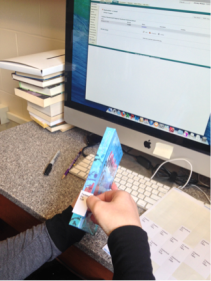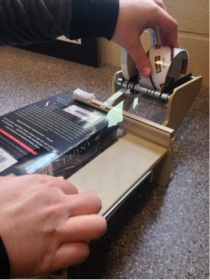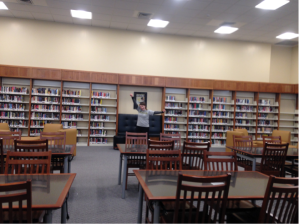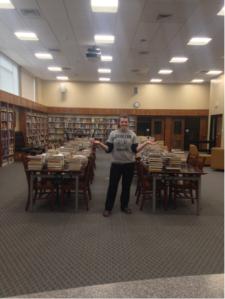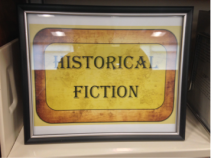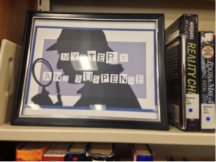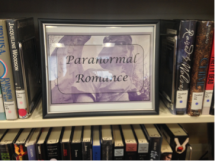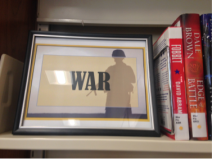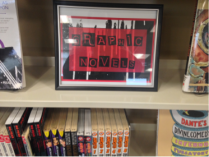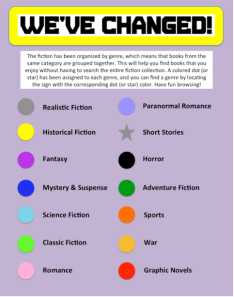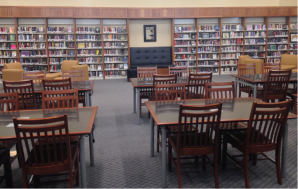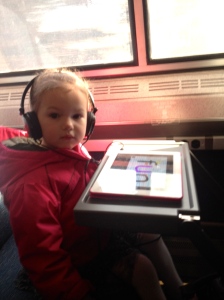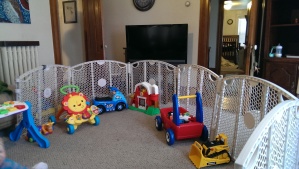I created this blog for one of my Library and Information Studies courses almost four years ago. I really appreciated the opportunity to share the projects I was working on with the greater library community. I’ve been a school librarian for the past few years now, and I absolutely love what I do. I started blogging about my programs and plans for my school library on my new blog, Library Jam. One of my more popular posts on this blog was my Genrefication Project. I’m working on a similar project at my new school, so if you’re looking for details to help with your genrefication process please check out my new site. Thank you!
“Genrefying” a High School Library: A Detailed Planning Document
This detailed planning document provides an overview of the school project I undertook for LSC 530, Texts and E-Tools for Tots and Teens, at the University of Rhode Island. For this project I “genrefied” a high school library in Massachusetts. “Genrefying” has been a topic that has interested me for many years; however, a project of this magnitude is hard to complete without dedicated and focused staff time. When LSC 530 students were given the choice to choose a school or community project, I knew this would be the perfect opportunity to merge theory with practice, applying the concepts and Learning Outcomes of the course to create something that would benefit thousands of high school students in the years to come.
Rationale
Texts and E-Tools for Tots and Teens focused on how media, of all types, impacts babies, children, and teens. For this project, teens and their relationship to young adult (YA) books was considered, specifically how a library’s fiction collection could be arranged so that teens can find books that meet their definition of “quality.” “Genrefying” means organizing books by subject, category, or genre so that patrons can find materials that interest them easier. Related to the BISAC method, or the Book Industry Standards and Communication, in which customers at bookstores or patrons at libraries browse books by category or subject title rather than by the Dewey Decimal System, it is an ideal way of organizing materials for people who are looking for a type of book rather than a specific title or author. By genrefying a high school library it helps teens find quality titles they may have never thought of trying. As Jack Martin, director of the Providence Public Library said, the best people to judge quality teen literature are the teens who are reading them (Hobbs, LSC530 Texts and Tools for Children and Youth, April 9, 2014). This helps librarians become more informed gatekeepers, aware of what their teen patrons want to read and developing the collection based on those needs. Instead of librarians being the judge of “high art” or “quality” literature, deeming what teens should be reading rather than what they actually want to read, shouldn’t librarians consider, “the form of a work and the enjoyment it brings,”(Verschoor, 2011)? Through genrefying the collection, it allows librarians to observe teens and the genres they flock to, it also specifies circulation statistics by showing what genres receive the most and least checkouts. Instead of purchasing books that you think your patrons will like, why not start ordering books you know teens will love!
In this course, we’ve read Kimberly Reynold’s text, Children’s Literature: a Very Short Introduction, which talked about the power of genres to aid in literacy of children. For ELA students or those reading at very low levels, genres can be used as a literacy tool to get these teens excited about reading as well. Reynolds (2011) said of genres, “the constraints of convention can be a spur to innovation, provoking writers to explore the possibilities for simultaneously conforming to and transcending genre expectations (p. 78). For teens who are struggling readers or having trouble connecting to the English language, the sense of familiarity genres afford, allowing students to “anticipate” plots and giving them, “confidence, stamina, and satisfaction” as they connect with books, is another benefit to organizing a fiction collection by genre. Teen readers, like children, may be drawn to certain genres, and rather than inhibiting their literacy skills, choosing books from the same genre can provide numerous benefits. Genrefying a fiction collection makes it easier for teens, and their teachers, to find books that may help them become better readers.
Virginia Walter (2010) talked about the importance of reader’s advisory in promoting reading (p. 30). Genrefying a library is a surefire way for librarians to know their collection and help them find books that meets a specific patron’s needs. Genrefying opens up so many opportunities for reader’s advisory. Through this process, librarians need to choose a genre for every title in their fiction collection. That means they have to read what each book is about. When students come to the library and ask for recommendations of books, there is so much knowledge to draw upon, and if no specific title comes to mind, the librarian can show the genre section that most relates to what they are looking for. Possibilities for reading maps, LibGuides, and book talks are endless with a collection organized by genre.
Throughout this project, I heavily relied on reader’s advisory websites like Goodreads, Amazon, and the database Books and Authors that provided me with clues to figure out which books belonged in which genre. What I found really useful were the professional reviews from places like the School Library Journal or Kirkus Reviews that are sometimes listed on these websites. They gave me additional genre clues and helped me learn more about titles. In this course, we talked about the power of review websites and what they can do for librarians. For my purposes, these reviews were very helpful for collection development and marketing. They gave me a wonderful base knowledge about hundreds of YA book titles so I can better help my patrons. These are a few ways this project aligned with the concepts and Learning Outcomes in this course. It provided me with extensive knowledge on the role media plays in the lives of teens, it taught me the variety of content available through YA books, and it helped me understand how to curate materials to meet teens specific wants and needs.
Context
If you have ever visited a high school library, one of the problems you might observe is the little time students have to search for a book. Another common problem for classes that require their students to choose a book for an assignment are the complaints from students who say they can’t find a book that interests them. However, what you’re likely to hear most from students are reader’s advisory questions where they ask the librarian to help them find a certain type of book, rather than a specific title or author. Here are some common questions:
- “I don’t really read, but I did like Where the Red Fern Grows in the fourth grade. Do you have any books like that?”
- “Do you have any mystery or horror books, something scary like Stephen King?”
- I like series books, like Percy Jackson and the Lighting Thief. Does the library have any series books like that?
These are the type of questions the school librarian and I, the library assistant, field regularly at Monty Tech, a high school with a student body population close to 1,200. Since the beginning of the school year, we have had many students ask us where they can find books like the Hunger Games, or mystery or horror books. With the exception of John Green and Ellen Hopkins, we have had few questions from teens asking us to find books by a certain author. The fiction collection is organized alphabetically so it was clear that our system could be designed in a way that would aid our patrons in finding books they like. Also, many teens, if they don’t find a book by browsing the expansive alphabetized collection leave without saying anything. There are patrons that ask for our help, but I’ve only seen a few actually look up books using the kiosk. Teens just have trouble finding the books they’re looking for. Genrefying was the best solution to connecting teens with the books they love.
The high school renovated their dark, dingy, and unoccupied library media center into a beautifully designed school library that students love. The current collection has a total of more than five thousand books, and the fiction collection makes up a little over 2000 of that. When I started working at Monty Tech at the beginning of the year, the school librarian and I were put in charge of ordering new materials, taking older materials out of storage, and arranging the new library. Aware of the needs of teens in school libraries, one of the ideas we had was genrefying the fiction collection. While the librarian did create foundational Google Docs to get the process started, the library was very busy with class visits, assisting students, and daily operations that the genrefying project took a back seat.
When a school or community project was proposed as an option for the final project in LSC 530, I knew this would be a great opportunity to apply what I was learning in class in a way that would benefit the students at Monty Tech. I asked the school librarian if I could take charge of the project for this course, and she was very receptive of the idea but questioned if it could be finished by the end of the semester. It was a project she was planning to take at least a few years to finish. I was confident it could be finished; not understanding how long a project of this size actually takes if only one person is working on it. I cataloged from home, chipped away bits and pieces at work when the library was slow, and stayed after work to the complete the project on time.
Aims and Goals
My goal is that we will see a significant increase in circulation by the same time next year. Many libraries that genrefy their collections say their circulation statistics increased by 30% within a few months. While I think this may be a bit slower in a school library because students have other schoolwork, I do think we should see results by the beginning of next year. This matters because a busy library is a funded library.
Another goal is to be able to physically see what genres we need to build up and those that need weeding. It is difficult to assess this when all the books are mashed up together. For instance, I believed science fiction was one of our biggest genres because those are the books I see cross the circulation desk most often. After the books were separated, the library didn’t have nearly as many science fiction books as I thought. Related to this goal, I hoped to figure out how the collection could be developed to attract male readers or the traditional “non-readers.”
My educational goals were to become more knowledgeable of YA literature throughout the project, learn about the popular content in YA materials, and use this information to curate a collection that meets teen’s definitions of “quality.”
One of my aims for the next year is to see more students using the school library to find books. Some of our teens are devoted to certain authors (like John Green or Ellen Hopkins), and the genrefying project will put similar books next to their favorite authors, hopefully introducing them to new books they may have never considered. For the non-readers who complain that there are no good books, categories that are created (like War, Sports, or Graphic Novels) may pique their interest. An alphabetized system can be intimidating for teens that don’t use or don’t know how to use library. Because of this, some students avoid the library entirely. If non-readers have a place to start, a place that informs them of the books they are about to pick up, perhaps they’ll find materials they will enjoy.
Stephanie Sweeney (2013), a secondary library teacher, wrote about her experience genrifying her library in YALSA saying, “The task required a great deal of planning and hard work, but I believe it has improved patron access by helping them be more independent searchers and discover new authors in genres they already favor” (p. 45). A patron of the Darien Public Library (2009) in Connecticut had this to say about the library’s new browsable model, “The books everywhere, but especially in the children’s room, have been shelved, labeled, and organized in a way that makes me feel less like a moron and more empowered to find what I’m looking for on my own.” A group of women who genrefied an elementary school library (2012) wrote, “Kids who’d previously had trouble choosing a book for independent or pleasure reading loved this new and easier-to-navigate arrangement.”
One of my biggest aims is to see patrons look for books on their own rather than come straight to the circulation desk asking for assistance. We love to help students find books to read, it’s actually the part of my job I like best, but the teens have been reluctant to use the computer kiosk to search for books, and because they weren’t exactly sure what they were looking for, it made it hard for teens to choose a book in the small amount of time they had to search. The goal is for students to become more independent searchers, feeling empowered that they can find their own books rather than needing to ask an adult for help.
Process Overview
The genrefication project had five major steps:
- Re-cataloging and assigning a genre to every print fiction title
- Print and tape the new genre spine label for each book
- Stick and tape a colored dot to each book signifying its genre
- Shelf the books alphabetically within their genre
- Create signage to display each genre
While the steps may seem very straight forward, each step took a significant amount of time. The fiction collection is made up of over 2000 books, so 2000 books needed to be re-cataloged, needed spine labels, dots, and tape, the books needed to be separated into the fourteen genres and then re-shelved. I needed to make attractive and interesting signage that clearly represented the genre. This was the original timeline:
This was the actual timeline:
The process was much more time consuming than I originally planned. Cataloging took me almost a full month longer, and I ended up labeling books with spine labels as I went to break up the monotony. With the conclusion of the project, I am confident that after time the aims and goals will be met, and possibly exceeded.
Process Details
To begin, the school librarian and I chose the genres that would represent the collection. We chose fourteen genres and matched them with colors based on dots Demco and the Library Store had available. Here are the genres we selected and their corresponding colored dots:
After the genres were chosen, the school librarian created two Google Docs to get the project underway. She created a Library Title & Copy List that I worked off of to make sure every title was re-cataloged.
Here is an image showing the list:
The other document the librarian created was a Subject Integrity List. She assigned a Call Number, Subject Heading, and Resource List heading for each genre so that when I was re-cataloging I could copy and paste from this document to ensure every new record was accurate. Here is the Subject Integrity List:
Watch this step-by-step process to see how I changed nearly 2000 records to reflect their genres:
The call numbers were changed so new spine labels with the correct call numbers could be printed and later found on the shelves. The genre needed to be included among the subject headings so when patrons search a keyword in the catalog, like “Fantasy” or “Horror,” every book with that genre as a subject heading would be presented as an option for the patron. Finally, my favorite tool is the Resource Lists. When you select a subject list in the catalog for each book, you are creating a searchable list that patrons can browse for each genre.
Here is a picture of the Resource Lists that is available to search on the homepage of the school’s Follet Destiny Quest catalog:
I was able to re-catalog 30-35 records every hour, and with a total of 1926 records (not including duplicate copies) it took me around 65 hours to complete the catalog portion of this project.
In the timeline, I proposed that I would finish all cataloging before I began putting labels on the books. I decided to start the labeling process when I was halfway finished with the cataloging. Cataloging was something I could work on at home, but labeling had to be done in the library. This system worked pretty well and made the process more bearable. I did catch up to myself a few times, having to take a break from labeling to re-catalog more books.
The first step with the labeling process was scanning the books directly into a barcode’s list, downloading the list, and printing out the spine labels. Because I took around 30 titles alphabetically from the book shelves at a time to receive a label, many books had the same call number (ex. FIC SOM). I had to scan each book to make sure the new genre spine label was assigned to the right book. Once the spine label was in place, I taped the label on, and if the book was paperback, I taped the entire binding to give the book more durability. The book was then placed back on the shelf in the order I took it down. Because this process took a while, it would have been impossible to seperate the books as I went, and the school librarian suggested I wait to put on the colored dots until closer to the project’s end.
Here are pictures of me scanning the book, sticking the label onto the spine, and securing the label and binding with tape:
After all of the labeling was completed, I stuck on the colored genre dots to match the genre of the books. Again, I took books off the shelf alphabetically, stuck on the dot, taped over the dot to secure it, and put the book back on the shelf in alphabetical order. Books were still not placed with their genre at this point.
Here is a picture of me putting a genre dot on a Fantasy book:
I finished cataloging, labeling, dotting, and taping on April 23, the Tuesday during April Vacation week.
Here is a picture of me in front of all of the cataloged and labeled books:
My original plan was to completely genrefy the collection before students came back to school after April break. I was able to accomplish this ahead of schedule. I had a helper assist me in combing through the labeled collection to organize books within their genres. We placed books in carts alphabetically so we didn’t have to arrange them again after they were put in their genrefied groups.
Here is a picture of the books being separated into their genres:
Here is a picture of me in front of all of the fiction books separated by genre on the tables:
The next step was re-shelving the books by genre based on the number of books in each category.
Books were arranged in this order:
1. Realistic Fiction
2. Fantasy
3. Historical Fiction
4. Mystery and Suspense
5. Science Fiction
6. Classic Fiction
7. Romance
8. Paranormal Romance
9. Short Stories
10. Horror
11. Adventure Fiction
12. Sports
13. War
14. Graphic Novels
We had hundreds of Realistic Fiction books but only a few books on War. We elected to keep Graphic Novels at the end, separating them from the rest of the collection. At the beginning of each new genre I placed an 8X10 framed sign I had created to display the next genre. The fourteen signs made shelf space extremely limited, and I had to move books around quite a bit before everything fit just right.
Here are pictures of the genre signs I created:
Here is a sign that explains the new system to students:
We finished re-shelving the fiction collection at the Monty Tech school library on April 25, 2014, five days ahead of schedule.
Here is a picture of the completely genrefied library:
Assessment
A week of school has gone by since the library was genrefied. This isn’t a lot of time to do a formal assessment or study circulation statistics to see how the project has affected checkouts. Therefore, my assessment is based on student reactions to the project. On the first day back from April Vacation, the sign explaining the new system had not been printed. Instead of offering help to teens as they searched for books, I deliberately observed how they searched for books. Essentially, I wanted to see if they understood the system without having to read directions from a sign.
I observed three teens, two girls and one boy who frequent the library. They all noticed the difference immediately and walked up and down the rows of shelves trying to figure out what was going on. A light bulb seemed to click for each of them, and because I am familiar with their reading habits, I saw them begin browsing for books in their favorite genres. One girl was attracted to Realistic Fiction, the other girl to the Paranormal Romances, and the boy to Fantasy Fiction. Each of them found a book and checked one out. I asked them if they understood the new system and what they thought about finding new books with the new set up. One girl said, “I think having the books separated in genres will help because people will be able to find the books they like easier. Many people don’t know particular author names so that’s helpful.” The boy said, “I was confused at first, but I think it will be a lot easier now to find books.”
Based on my observations and student feedback, it was apparent that it took the teens a little while to figure out the new system. There were confused looks but there was definitely a point when they understood it. Once the students got to that point, it seemed like they were able to enjoy browsing books in their favorite section and find a book that interested them. Based on the boy’s comments, I made sure to have my sign with directions hanging in the library the next day. Most students spot the sign, but we can easily refer students to it if they have any questions.
On Thursday, an English teacher brought down two of her classes to choose a book for a paper they were assigned. She asked us ahead of time to pull titles that the teens may find interesting. This system made it so much easier to choose selections for students. I quickly made an, “If you liked Hunger Games…” section by searching the Science Fiction genre, I made a section for Twilight lovers by pulling books from Paranormal Romance, and I made five other section that would peak their interests in a matter of 20 minutes. Normally, I would have had to have a title in mind, search for it in the catalog, and then find it. With the new system, I was able to complete a reader’s advisory task in much less time.
What was most interesting, but not necessarily surprising, was how students from the two English classes gravitated towards particular sections. After I briefly explained to the classes how the new system worked, I showed them the direction sign, and let them begin browsing. They all visited the sign first to figure out what they wanted to read, and then found the genre among the shelves by spotting the genre sign. 90% of the boys flocked to the Sports and War genres, while many girls could be spotted in the Romance, Paranormal Romance, and Realistic Fiction sections. It was really helpful to see an example of this early on. Normally, we would have had 15 boys in the library asking the librarian and myself for sports books or survival books, or they would’ve grumbled that there was nothing to read. While we still heard a few grumbling students, most boys walked away with a book they found on their own.
After organizing the collection by genre, I was able to fulfill one of my goals by spotting the genres that needed severe developing. The Realistic Fiction collection has over 500 titles, the Sports section has less than 50, and the War genre only has 19 books. After having the two classes down for a visit, it is very clear that the library needs to purchase more sports, adventure, and war books because that is what most boys at our school prefer to read. When the collection was arranged alphabetically, we knew there were sports and adventure books but we didn’t know how many. Genrefying the library solved this problem.
There were a few changes I would make in retrospect if I were to undertake this project again. I was a little disappointed about was how much room the genrefying signs took up on the shelves. I wasn’t anticipating how little space we’d have left after the genres were organized. Because the school has a healthy book budget (we’re actually getting over 300 new fiction books in a few weeks), growth is a concern. We have less space to work with, so we need to do some weeding and will likely need to convert the signs to a 5X7 or buy another bookshelf to make room.
A project of this magnitude takes time, and it would be useful to have a team or student helpers work on this project simultaneously. Also, for a school library, the best time to complete a project like this is during the summer when you can take your time, make a mess, and put the library back together beautifully before anybody notices a difference.
Though there were bumps along the way, I learned so much through this process. I feel very fortunate that the school librarian let me take charge of a project this size and trusted my judgment on the layout of the fiction section. I learned so much about YA literature, how to provide better reader’s advisory services and develop the collection to meet teen’s versions of “quality.” Most of all, I am excited that I was able to complete a project that will be used by thousands of students in the years to come, making it easier for them to connect with the books they love.
References
Fister, B. (2009, October 1). The Dewey dilemma. Retrieved April 28, 2014, from http://lj.libraryjournal.com/2010/05/public-services/the-dewey-dilemma/
Kaplan, T. B., Dolloff, A. K., Giffard, S., & Still-Schiff, J. (2012, September 28). Are Dewey’s days numbered?: Libraries nationwide are ditching the old classification system. Retrieved April 28, 2014, from http://www.slj.com/2012/09librarians/are-deweys-days-numbered-libraries-across-the-country-are-giving-the-old-classification-system-the-heave-ho-heres-one-schools-story/
Reynolds, Kimberley (2011). Children’s Literature: A Very Short Introduction. Oxford University Press.
Sweeney, S. (2013). Genrefy Your Library: Improve Readers’ Advisory and Data-Driven Decision Making. Young Adult Library Services, 11(4), 41-45.
Verschoor, B. (2013). Say hi to high, hello to low. Retrieved April 21, 2014, from http://www.arenastage.org/shows-tickets/sub-text/2011-12-season/the-book-club-play/hi-to-low.shtm
Walter, Virginia (2010). Twenty First Century Kids, Twenty First Century Librarians. Chicago: American Library Association.
Genrefying a High School Library
In this Ignite Presentation, I show you the process I went through to genrefy a school library’s fiction collection. I undertook this school project for the course LSC 530 at the University of Rhode Island. Watch the video to learn a little about genrifying, how it relates to this course, and the steps I followed to complete this project on time. Enjoy!
Reflective Essay #2: The Power of Media
It will be sad to say goodbye to LSC530, Texts and Tools for Children and Youth, this semester. I am a distant learning student at the University of Rhode Island. The closest I came to taking a face-to-face class while pursuing my grad degree at URI was a course that met every other week. Not being able to interact with classmates and have open dialogue with the professors of my classes has been my biggest struggle while pursuing my MLIS, and even though I wasn’t able to join the Google Hangout, it felt like I was a participant just by watching my classmates and our inspiring professor, Dr. Renee Hobbs, interact and share ideas with one another week after week.
Beyond the Google Hangouts, every aspect that was incorporated into the course taught me something. I loved learning to utilize new technology, like TitanPad, Flipgrid, Padlet, Twitter, WordPress, Storify, and Youtube Playlists, but I especially enjoyed seeing how my classmates interpreted these tools. Dr. Hobbs gave us a chance to be creators ourselves with our Multimedia Reviews and final projects. This has been a breath of fresh air compared to the traditional online format that generally allows for little creativity and meaningful interactions with classmates. I thought the required readings and videos were very informative. The content that really struck me in the latter half of the semester was our discussion on “quality” children’s literature, copyright and fair use, and the benefits and cons of children writing fan fiction. Additionally, I am always intrigued with discussions on screen time with young children and the importance of interaction between children and adults.
When I signed up for the course I envisioned myself as a children’s librarian perusing the shelves with a mother and child after she asked for my assistance in finding “good” children’s books. I believed LSC530 might give me a list of necessities I could check off in my head that would help me filter the quality books from the rest. One of our latest classes dealt with exactly that, what makes a “quality” children’s book? We used the Padlet wall to map out the similarities and differences of professional and amateur writers. Are quality pieces only written by professionals? While I loved hearing and reading everyone’s thoughts on what makes quality children’s literature, the values it teaches, the specific content, reflecting on earlier works that are heralded as “classics” etc., I was totally mesmerized by what Jack Martin, the director of the Providence Public Library had to say on the topic. He proposed that instead of adults being the judges of “quality” why not consider that the children/teens are choosing books because they represent “quality” materials to them. I thought this was awesome! There’s no other word for it.
In Ben Vershoor’s (2011) article, Say Hi to Low, Hello to High, he mentioned the influential Susan Sontag saying she, “ pushed back against the academics, who only considered works of art in light of their political and social content, and argued that the form of a work and the enjoyment it brings should be considered first” (para.9). For the end of the semester class project I am working on reorganizing the fiction section of a school library by genre. Throughout the process I have learned so much about YA literature, like what types of books are currently being published, what books are popular, and what genres see the most check outs. At the end of the project, students will be able to easily find books that interest them, books they deem are “quality” literature, which will in turn give me insight into “quality” books for teens so that I can better develop the collection.
Our lesson on copyright and fair use was also very enlightening. Last semester I took Information Ethics and Policy and we thoroughly covered these topics, however I feel our perception of copyright infringement is ingrained deeply within us that it can be easy to forget what constitutes fair use. Ever since I was young I was a copycat. I love to draw and actually taught myself from copying pictures on children’s DVDs. That transferred into my adult life, I paint pictures of other people’s masterpieces to hang on my wall. When I first started working in libraries I had so many good ideas for programming that involved Dr. Seuss and other popular children’s books. Working at a very small library with no programming budget I thought I’d use my artistic skills to paint The Cat and the Hat as a prop. I was warned that that would be copyright infringement, and it scared me half to death! All my life I’ve been copying other artist’s works! Since then, I have been searching for an easy to reference list that tells me what I can and can’t do, but fair use isn’t black and white. It provides us with guidelines to assess the purpose behind our using copyrighted work. Carrie Russell (2010) referenced the four factors of fair use saying, “Consider why you are using the work? Is the use necessary to illustrate a point? Will you use the work in a way that is “transformative,” making use of the work in new, socially beneficial ways not anticipated by the rights holder?” (Copyright Tips for Programming Librarians, para. 7). Further study of copyright and fair use in this class reinforced the idea to analyze why I’m using a copyrighted piece.
Another topic that was personally interesting to me was the notion of the amateur author, particularly children as authors of fan fiction. One of the videos we watched in our lesson poked fun at fan fiction, mentioning that some of the most popular fan fiction stories are about the band One Direction. I thought this was pretty entertaining, but then I started thinking about my obsessive teenage self and all of the quirky things I did. I remembered that I also was an unintentional fan fiction author at age 14. I took a creative writing class my freshman year of high school, and the final story I submitted was a piece I had written about Tom Brady. It was corny and cheesy looking back, but I took it very seriously at the time.
In LSC530 we discussed some of the pros and cons of children and teens writing fan fiction. Some argued that fan fiction takes the creativity out of writing because the author is relying on the audience’s knowledge of original creator’s characters instead of developing their own characters. Additionally, some mentioned that fan fiction writers tend to rely on overarching plots that the original author developed; again taking away creativity normal writers would need to invest. I tend to view fan fiction as a positive thing. Though some creativity might be taken out of the process, children are writing for the fun of it! Fan fiction provides youth with a venue to create and compose, learning about the parts of a story, learning how to use language to cause some sort of reaction to the reader. Much like how people say it doesn’t matter the media as long as children are reading, I believe the same notion applies for writing. Though the result may not be as pretty as some English teachers may like, children are writing because they enjoy it, accepting feedback from peers, and learning in the process.
In my first reflective essay, I highlighted screen time as the most interesting topic we focused on early in the semester. In our latest lesson, part of our study on media and values touched on screen time again. How much screen time is too much and for what age? Bringing the conversation back to values, what can parents be doing with their children instead of permitting them, sometimes encouraging them, to watch TV or play on an electronic device? As I was composing my Storify, I came across this wonderful little video created by a public library that said parents reading with their children is the number one activity parents can do to help children get ready to read:
Screen time cannot take the place of real interaction between young children and adults because it lays the foundation for developing language and early-literacy skills.
It is clear that I have learned a lot from LSC530, from technology tools to course content. However, with the semester coming to a close, reflecting back on the past few weeks I regret not participating more in the Twitter dialogue between my classmates. I did participate in after class activities and thought it was extremely helpful to “do” something with the information we were learning, applying that information to our own lives. That being said, it was challenging to stay on top of the variety of tools that aligned with our asynchronous assignments, and for me, elements that weren’t required seemed to get left behind. On a different note, I appreciate that Dr. Hobbs didn’t require students to participate live in the Google Hangout. I am very glad I didn’t miss out on the course because I wasn’t able to interact live. I think if weekly live participation was required in the future, than the course listing on e-campus should make this known to students because the online structure of LSC530 is very different from other e-courses.
What I’ve learned this semester is that media plays a central role in our lives from the time we are infants. Parents, teachers, librarians, and media professionals have the exciting opportunity to collaborate with one another to ensure children’s interactions with all forms of media are positive and appropriate for the age of the child. Media shapes our outlook on life. Let’s make children aware of the potential media has to change their perspectives. Let’s ensure they’re digitally literate. Let’s make sure they are ready to interpret texts and tools from an early age.
My son, Sawyer, exploring books.
References
Russel, C. (2010, February 17). Copyright tips for programming librarians: Using images in programming materials. Retrieved April 21, 2014, from http://www.programminglibrarian.org/planning/copyright-tips-programming-librarians-using-images-programming-materials#.U1ciBl60b1o
Verschoor, B. (2013). Say hi to high, hello to low. Retrieved April 21, 2014, from http://www.arenastage.org/shows-tickets/sub-text/2011-12-season/the-book-club-play/hi-to-low.shtml
Fair Use Analysis of My Video, “Miss Christy’s Storytime”
In the story time multimedia video I created I utilized three copyrighted materials, Dr. Seuss’s books Mr. Brown Can Moo, Can You?, Green Eggs and Ham, and The Cat and the Hat. I did use Animoto to make an introduction to the story time, however Animoto does not claim ownership over videos one creates. The question is, was it legal for me to use Dr. Seuss’s works even though they are copyrighted? The answer: YES! Thanks to the Fair Use Policy, my video is not infringing copyright because the video was made for educational purposes, and the task was an assignment given to me in an educational setting. Additionally, the intent of the video is to educate young children, teaching them about authorship by showing them the three books, encouraging them to follow along with the story through text and pictures, teaching them concepts like loud and soft, and also finding out what noises various objects/animals make.
Further, I added creative content to the works. I introduced the books with a video I made, pictures I took, objects I crafted. I edited the video to include transitions, and Mr. Brown Can Moo, Can You? was read in a way that was unique to me. Yes, the book was originally created to be read, however the way that it was created to be read, either by a child to him/herself, by a parent/caregiver to a child, or by a teacher to a class is different them using multimedia tools to share it over the web. I did read the entire book because it was necessary to accomplish the goal of the project. It is really true that the Fair Use Policy doesn’t just protect original creators, but users too. If we were never able to use Dr. Seuss’s work in the library to educate children than it would be very unfortunate.
Multimedia Playlist – Dr. Seuss for Everyone!
I had a great time compiling videos that shared connections to my Storytime where I read Dr. Seuss’s Mr. Brown Can Moo! Can You?. This video can be found in my previous post. The variety of videos with people reading Dr. Seuss books was astounding, and I decided to show some of this variety in my Playlist. From musicians turning Mr. Brown Can Moo! Can You? into a catchy song, to a famous football player sharing a book, to a young child having fun with this silly story, each video has unique elements that make them an effective digital media literacy tool. Enjoy!
Miss Christy’s Storytime
Join Miss Christy as she reads Dr. Seuss’s wonderful book of noises: Mr. Brown Can Moo! Can you?
Reflection on the Multi-Media Review project
I’ve really enjoyed taking LSC530 this semester with Renee Hobbs. What I love most about the class is the practical nature of our projects. We are learning new sets of skills that we’ll be able to develop further in our jobs or utilize in our personal lives. We have learned how to connect and network on Twitter, have created our own blogs on WordPress, tried new tools like TitanPad, Flipgrid, and Padlet, and with this project we had the opportunity to create original multi-media videos.
I am always a little nervous when it comes to recording myself or being in front of a camera, but this project was really fun because I enjoyed what I was doing. I decided to do a Read Aloud of Dr. Seuss’s Mr. Brown Can Moo! Can You? Who doesn’t think fondly of Dr. Seuss in March, the wonderful author who transformed children’s literature in his own unique way! I read Mr. Brown Can Moo! Can You? with my son this past year for the first time in my life, and I was so surprised I had never been introduced to it before. It’s a really fun, silly book, and it grabs children’s attention because of all the funny noises one makes when reading it. The text is nice and large over a white background, making it the perfect choice for an early reader. I thought this story would be perfect to share with a young audience over Storytime because it engages the audience and allows for participation without straying from the story.
I knew I wanted an introductory video to set the mood of a Storytime. I had originally wanted to do my favorite finger play after the introduction to make it feel more like a Storytime, but the video was a bit too long to begin with. I decided to use Animoto to create the introduction and closing video. Animoto is a really fun, easy to use tool that allows the user to share words, pictures, and short clips in a pre-arranged graphic video. Animoto even lets you choose a song to match the theme of your video. The video I chose was colorful, upbeat, and had a sense of whimsical fun that I thought would be appropriate for a younger audience. In the introduction, I attached some of the pictures I had taken from a Dr. Seuss program I did a few years ago, including pictures of two children with homemade Cat in the Hat props.
The Read Aloud, as I mentioned, was a lot of fun and straight forward. I wanted to mention Dr. Seuss and who he was before I read the story. I made sure to trace along the text with my finger every so often, and “interacted” with the audience asking them to join in making sounds with me. To conclude the video, I took a short clip of the introduction video and reworked it for the end. I used iMovie to bring the three segments together and help them transition smoothly.
I hope you enjoy my video as much as I enjoyed making it!
Reflective Essay #1
When I originally signed up for LSC 530, Library Resources for Children, I had no idea I would be creating a personal blog, tweeting, interacting with classmates live over the Titan Pad, recording my thoughts over FlipGrid, and utilizing Animoto to make virtual connections with classmates. I received an email from Dr. Renee Hobbs on January 13, 2014, which informed me that the class was transforming into LSC 530: Texts & E-Tools for Tots to Teens. I was really excited about the change because, although I love technology, I haven’t had time to join and participate in various Web 2.0 tools that I think would be useful for outreach, education, and interacting with young people in the library. I was also a little apprehensive because my goal is to be a youth services librarian, and I want to learn and develop certain skills that I need to be successful in this field, like how to engage children during story time. I was afraid that attention would be taken away from, what I thought were, important concentrations that would help me grow professionally. Since then, I am glad to say that I have learned so much about youth and their interactions with media that will not only help me “on the job,” but will reflect the decisions I make as a parent.
The videos and readings in LSC 530 have been providing me with a base knowledge about youth and media. In particular, Sonia Livingtone’s (2009) reflection on how society has changed for children in the second half of the 20th century, highlights how children are spending more time in the home then ever before and are looking for things to do (p.14). As families purchase new technology, older models work their way into bedrooms. If this technology has Internet capabilities, it provides children with access to infinite information via the web. The web allows children to become creators, express themselves, and interact with their peers. However, it can introduce negative information to young browsers and may lead to “harmful or criminal activities” (p. 28). Livingtone points out that “Despite the growth in numbers of internet users, a rather small minority of these users has the capability to use the internet in ways that are creative and that augment their ability to participate effectively in today’s knowledge societies” (as cited in Mansell, 2004, p. 179). This information is very practical and reminds me of Virginia Walter’s (2010) statement about children, “Yes, they are digital natives; computers and the Internet have been around since before they were born. This doesn’t mean they know how to use them effectively…” (p.61). It cannot be assumed that just because a kid has had access to particular technology device since he was a tike means he/she knows how to use and create with it.
Lisa Guernseys’s (2007) contribution on the ways young children interact with digital media has been very enlightening as well, particularly her focus on babies and screen time. As a mother of a ten month old, I am constantly wondering what is best for my child. This worry includes how much, if any, TV my baby should watch when I am washing the dishes or writing a blog post for my class. Guernsey stresses the “Three Cs”. Parents need to consider the “content” of the program, the “context”, or when your child is allowed to watch TV, and the “child,” or the needs of the individual child (p. 254). There are studies, however, that show a link between the amounts of TV a baby watches and how quickly that baby’s language skills develop (p. 257). In his video presentation, Media and Children, Dimitri Christakis (2011) shared studies that have compared how much television, and what type of television, a young child watches and the chance that child has to develop some form of hyper activity and inattention problems because of it. These statistics enhance parent’s fears in their child using any technology at all.
Quoting Katie C. de Oliveira Anderson, a commenter of Christakis’s (20110 YouTube video:
“read them books people! kids love books! No iPads, games or longs TV hours for my kids, let them be kids, let them play outside on the grass with balls, rocks etc, get dirty and tired! I hate media and all kinds of ipad games no matter how they tell me that the games could be good for the kids!”
There is certainly a debate on the effect screen time has on very young children, but there are also innovators in the library field who incorporate media and technology into their story times because of the educational and interactive possibilities that exist with e-tools. Cen Campbell (2013), creator of LittleeLit.com, is one of these librarians, who are developing, “best practices for the incorporation of new media into library collections, services, and programs for children age 0-6.” Her video encourages viewers that children using e-tools is not a negative thing, but an exciting one. Incorporating technology to fit with children’s developmental needs is an important step that cannot be overlooked, especially when a site like this has researched how best to incorporate the tools with little ones.
As I mentioned at the beginning of the post, this class has introduced a plethora of new information to me on both children’s and teen’s relationships with media. However, the concepts highlighted above were the most meaningful to me as a new mother and as a person who cares deeply that all children have the chance to develop early literacy skills in the most effective way possible. It is very interesting to hear new developments in the early literacy field, and I, for one, cannot wait to incorporate LittleeLit.com’s recommendations for using e-tools in story times.
My niece, Addi, on the iPad.
LSC530 has been one of the more demanding courses I’ve taken online. We’ve utilized quite a few interactive tools that Dr. Renee Hobbs recommended we take advantage of. We are not only learning new tools but also are contributing what we’ve learned in the ways the format of the tools demand. Twitter, Titan Pad, the WordPress blog, and Flipgrid have allowed us to reach out to class peers, and provide feedback in those communications. I could definitely work on communicating more with my classmates, however.
I have used the recommended tools for every class and have completed the readings. I work in a high school library and I am very grateful that I can say I’ve used Twitter, and other applications, to form connections with the teens. The information about children’s literacy has been extremely useful to me as I raise my son. After watching Christakis’s video, I have purposefully steered clear of the TV when my son is awake. He is an early riser, and because I need the time to get ready for work in the morning, I used to put him in the jumper and turn on Daniel Tiger’s Neighborhood. I needed something to contain him (the jumper) and entertain him (TV) so I could get to work on time. This weekend I bought a baby pen so that I don’t have to turn on the TV at all, a place where he is safe and can play with his toys. I don’t want the TV to “babysit” my child, and I don’t want my actions to cause him hyperactivity later on. This is one practical way I have applied the readings and videos to my life.
Our beautifully redesigned living room.
For my research paper/creative project I am considering exploring the digital divide among teens and what it means for their educational career and social life. I work at a low-income school and many students do not have computers at home. Teachers are unable to dictate that the student’s papers must be typed unless they are given time to work on it in class. This issue effects so many teens today. They are at a distinct disadvantage when it comes to developing digital literacy skills.
Works Cited
Campbell, C. (Director). (2013). Opening Minds Innovation Award Application [Motion picture on YouTube]. United States.
Guernsey, L. (2007). Screen time. Basic Books.
Livingstone, S. M. (2009). Children and the Internet. Malden: Polity Press.
TEDxRainier – Dimitri Christakis – Media and Children [Motion picture on YouTube]. (2011). United States: TedxTalks.
Walter, V. A. (2010). Twenty-first-century kids, twenty-first-century librarians. Chicago: American Library Association.
“Blind Date a Book”… What a Success!
For a few years now I’ve been dying to try the display idea, “Blind Date a Book.” I finally had the opportunity to set up my own display in the high school library that I work at. The display was so popular it was hard to wrap books fast enough. In six days, 33 books were checked out from the display! I wrapped each book in brown paper, tied the books with twine and used my trusty die cutter to cut out tags that provided readers with clues as to what each book was about. I adapted the image found here to work for this particular display: http://www.etsy.com/listing/125120345/wedding-guest-book-alternative-3d-paper?ref=market.
Here is the result:
I would definitely recommend a “Blind Date a Book” display for teen audiences. Each book was like a little gift, and by providing clues hopefully students ended up with a book that matched their interests. We did have one boy embarrisingly return a certain book that was clearly marketed for lovers of Twilight. I somehow neglected to mention in the clues that the book revolved around a love triangle. However, most teens seemed pretty happy with the books they chose.
Media in My Childhood: I “Remember That Famous Day and Year”!
“Listen my children and you shall hear of the famous ride of Paul Revere…” were the lines that proudly bursted from my mouth whenever I recited Henry Wadsworth Longfellow’s famous poem Paul Revere’s Ride. I first read this poem in What Your Fifth Grader Needs to Know, an educational book my mother made us work on during the summer to “keep our brains sharp.” My mother had no way of knowing that an excerpt from a text book covering everything from grammar to earth science would influence my interests and my future so heavily.
I was seven years old in the summer I memorized Paul Revere’s Ride from that book, which isn’t an easy task if you’ve ever heard the poem. Even though it is far from short, the poem is so descriptive and exciting that I instantly became obsessed with Paul Revere, the Revolutionary War, and early national US history. Yes, the poem isn’t the most accurate thing ever written, but Longfellow’s work is the reason I love history to this day.
As a child, I grew up in Northern New Hampshire, but we visited my Nana in central Massachusetts a few times a year. I’ll never forget when my dad told my three siblings and me that we were going to walk the Freedom Trail, see where Paul Revere lived, see the Old North Church, and even see the graves of Paul Revere, Sam Adams, and much more! Yes, apparently I was a dweeb from the start. My mother let me take pictures galore, and I was so proud to bring them to my fourth grade class and show them to my teacher and friends.
In the fifth grade we had a parent’s night and each student was required to have a show-and-tell project to present to the adults. My fellow classmates had normal projects, you know, volcanoes and the like. Me, being the special child that I was, I raced my pet snails in a maze I constructed out of cardboard and construction paper, and I also dressed up as Paul Revere and recited Paul Revere’s Ride to parents passing by. A reporter even took my picture for the town paper. My mother still has the picture, and if I come across it I will certainly share it in this post.
Throughout junior high and high school my love for history continued. I dressed up as founding fathers, once as Benjamin Franklin sharing his personal biography and later as Thomas Jefferson. My mom helped me make a Thomas Jefferson puppet and I sang The Declaration of Independence (as heard on School House Rock) to my class. I also studied art and incorporated history into my work. I created a tribute to Paul Revere in color pencils in high school and later made a map of the Freedom Trail constructing prints I made of my friends and I visiting the different sites around Boston.
“Paul Revere” in color pencil
I ended up majoring in history in my undergrad. I met my husband, a history teacher, in 2007 and our first date was the trails at Lexington and Concord. When we reached the spot where Paul Revere was arrested by British officers I recited Paul Revere’s Ride on the spot as a memoriam to the patriot. My husband said he knew he chose the right person that day. I’m sure if it were anyone else they would have fled the scene immediately! I married my husband five years ago and had a baby last year. Before my baby was born, one of the very first books I bought him was Paul Revere’s Ride. I cannot wait to share my favorite poem, a poem that shaped my life in a lot of ways, with my son, and I really hope he appreciates the poem as much as I did and do.
My husband and my first date at Lexington and Concord.
My son, Sawyer, dressed up as Paul Revere at three months old.
There are so many books that I loved as a child that had a lasting impact on me into my adult life, but nothing compares to the poem that came into my life one day as I was complaining about doing school work during the summer. I am turning 27 in a few weeks so I first read that poem almost 20 years ago. I remember it as if it were yesterday, along with all of the little life’s moments that came about because of it. Books, TV shows, websites, movies and the internet play such influential roles in our lives, and the information we consume as children will impact and shape us into the people we become.
As I was doing the reading for LSC530 this week I was thinking how scary it is as a parent that media can influence our children so strongly. Livingtone (2009) said, “The mass media gave children unprecedented access to the adult world, blurring the adult/child boundary of knowledge” (p. 10). I work in a high school library and every once in a while a student will circumvent the security protection and visit inappropriate websites. I can understand both the optimists and pessimist views, the “Online Opportunities” and “Online Risks” of the internet for children (p. 30). As a parent, I fear the knowledge my son might come across too early in life, but I also look forward to the opportunities he will have not just to consume information, but to create with that information. As a librarian, I think it is so exciting to play a part in a child’s discovery of knowledge and ideas. I feel so honored to be able to recommend books and websites, tv show, websites and games to children and teens that will inspire them and help them learn and create. I cannot think of another job I’d rather do!
Livingtone, S. (2009). Children and the Internet. Malden: Polity Press.



